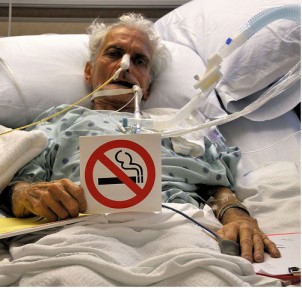Longer nicotine-patch therapy may extend abstinence
Smokers who use nicotine patches for longer than the standard eight weeks may stay off of cigarettes for a longer period as well, a study published Monday suggests.
The study, of 568 adults looking to quit smoking, compared the effects of standard nicotine-patch use with extended therapy - that is, six months versus the two months recommended by manufacturers.
After six months, researchers found, about 32 percent of patients on extended therapy were abstinent, compared with only 20 percent of those who had stopped using the patches after two months.
And when patients did fall off the wagon and start smoking again, those on the extended patch therapy were more likely to get back on the wagon during their treatment period, according to findings published in the Annals of Internal Medicine.
However, once patients stopped using the patches, the benefits of extended therapy faded. One year into the study, 14 percent were still abstinent - identical to the percentage in the standard-therapy group.
 The implication, the researchers say, is that extended therapy can lead to extended abstinence, at least as long at the treatment is maintained.
The implication, the researchers say, is that extended therapy can lead to extended abstinence, at least as long at the treatment is maintained.
“At the end of the treatment period, there were significant and clinically meaningful differences” between the groups, said senior researcher Dr. Caryn Lerman, a professor of psychiatry at the University of Pennsylvania in Philadelphia.
She said more research is necessary to see what the optimal duration of nicotine-patch therapy is - though that, Lerman pointed out, will vary from person to person.
The researchers say that studies should also look at whether additional therapies, such as intensive behavioral counseling or medication, boost the long-term success of extended patch use.
 No single quit tactic works for everyone, and a number of studies have suggested that some smokers do better on a combination of therapies.
No single quit tactic works for everyone, and a number of studies have suggested that some smokers do better on a combination of therapies.
A study published last month of more than 1,300 quitters found that 30 percent of those on nicotine lozenges plus the drug bupropion SR (a sustained-release form of Zyban) were still smoke-free six months after starting their quit attempt - as were 27 percent of those who used nicotine patches plus lozenges. That compared with 17 percent and
18 percent, respectively, of patients on the drug or patch alone.
For the current study, Lerman and her colleagues randomly assigned 568 quitting hopefuls to use 21-milligram Nicoderm CQ patches for either the standard eight weeks or 24 weeks. Those on the standard therapy were given placebo (inactive) patches for the rest of the treatment period. All patients were also offered behavioral counseling - every couple weeks to get started, and then monthly.
Overall, extended-therapy patients were 81 percent more likely to be abstinent at the six-month mark. They were also 47 percent more likely to get back on the wagon after any smoking relapses over the six-month treatment period.
“If you stay on treatment, you have a much better chance of recovering from a relapse,” said lead researcher Dr. Robert A. Schnoll, an associate professor of psychiatry at UPenn.
That makes sense, according to the researchers, because chronic nicotine exposure from the patches desensitizes nicotine receptors in the brain, which in theory should make smoking less rewarding.
Side effects were similar in the standard- and extended-therapy groups, with half of patients in each reporting symptoms such as headache, skin irritation and sleep problems at some point during their treatment.
If doctors do start prescribing nicotine patches for longer periods, cost could become an issue for some patients. Lerman pointed out that few insurers fully cover the products, which are sold over the counter. Prices vary, but a two-week supply of Nicoderm CQ patches, for example, typically costs between $50 and $60.
Lerman has served as a consultant to Nicoderm CQ maker GlaxoSmithKline; the study itself was funded by the National Institutes of Health.
SOURCE: Annals of Internal Medicine, February 2, 2010.